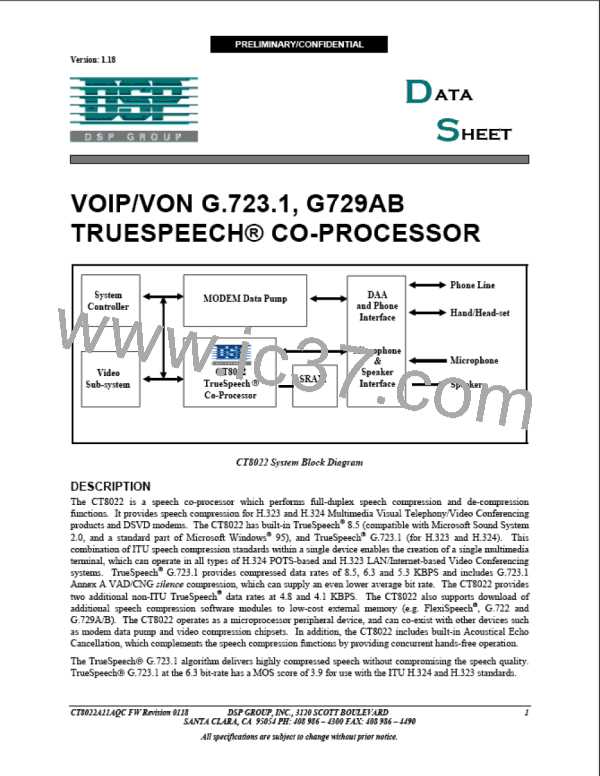TrueSpeech® Co-Processor
PRELIMINARY/CONFIDENTIAL
Version: 1.18
6.2
Data Transfer using the Software Control and Status Registers
This transfer mode is provided for software compatibility with the CT8015 and CT8005.
In this mode, the CT8022 supports data transfers using only the Software Control and Status Registers. This mode
provides backward compatibility with the data transfer protocol used in the CT8005 TrueSpeech 8.5 Messaging Co-
Processor and the CT8015 TrueSpeech 8.5 DSVD Co-Processor.
To perform data transfers, the Host must interrogate the CT8022 using the playback/record C2-S2-C3-S3
command/status sequence. When the CT8022 is ready to transfer data, it returns the available transfer count in the
S3 status response. The Host then performs the required number of command-write-status-read cycles using the
Software Control and Status registers to transfer the data.
6.2.1
Host Control/Status Register Data Transfer Synchronization Modes
The synchronization modes described here are for use only with speech data transfers performed via the Software
Control and Status Registers. The synchronization options control the manner in which data transfers are
coordinated with control operations performed via these registers. When data is transferred via the transmit and
receive data buffers, the CT8022 provides dedicated TX/RX ready/DMA signals.
Generally, the rate of transfer of data between the Host and the CT8022 must be synchronized with the rate at which
speech data is transferred between the CT8022 and its external CODEC(s). Data is exchanged between the CT8022
and the CODEC, one sample every 125 microseconds (at 8.0 KHz). This data is accumulated into blocks of 240
samples, which correspond to a period of 30 milliseconds. If the channel is operating in A-law/µ-law or linear mode
etc., this data block (or frame) is transferred to the Host without compression. If the channel is operating in
TrueSpeech mode (compressed), the frame is compressed before transfer. The 30ms period is derived from the
external CODEC clock by counting 240 samples.
The CT8022 devices are intended to be used in pairs, at opposite ends of a communications link. The CT8022 at
each end of the link will have its own external CODEC and its own independent clock source or crystal. Data is
moved between the two devices in real-time via the Host processors attached to each CT8022 at each end of the link.
Although the CT8022 clocks will probably be derived from a crystal source to generate the 8.0 KHz CODEC sample
rate, the precise frequencies of these clocks will most likely be fractionally different. The frequencies may well also
vary with temperature and time. As a result, one CT8022 at one end of the link will source/consume speech data at a
rate fractionally different from the CT8022 at the other end of the link. Over time, this difference will accumulate, if
left alone. If the playback channel at one end consumes data more slowly than it arrives, the transmit buffer queue
will gradually fill, increasing the apparent transmission delay until the transmit buffer queue becomes full. At this
point, frames of data will begin to be discarded. If the playback channel consumes data more quickly than it arrives,
the transmit buffer will become empty over time until the playback channel becomes starved of data. At this point
gaps will be introduced into the outgoing speech, or extra frames of data will have to be synthesized to make up for
the short fall in frames.
To assist with dealing with this end-to-end synchronization problem, the CT8022 playback and receive channels can
be operated in one of four different sync modes. The sync mode of operation of the playback (transmit) and record
(receive) channel can be selected independently. The CODEC Sync mode provides for backward software
compatibility with the CT8005 TrueSpeech Messaging Co-Processor.
The four sync modes are:
1. CODEC Sync Mode
2. Data Sync Mode
3. Poll Sync Mode
4. Host Sync Mode
44
DSP GROUP, INC., 3120 SCOTT BOULEVARD CT8022A11AQC FW Revision 0118
SANTA CLARA, CA 95054 PH: 408 986 – 4300 FAX: 408 986 – 4490
All specifications are subject to change without prior notice.

 ETC [ ETC ]
ETC [ ETC ]